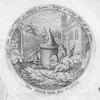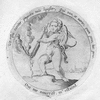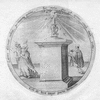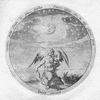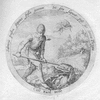Introduction
This is our edition of Emblemata amatoria of 1607/8. In this introduction, we have limited ourselves to the essentials.
About Daniël Heinsius
When these emblems were first published in 1601, they carried a different title (Quaeris quid sit amor?, see [Titlepage]) and were presented by an author who identified himself as Theocritus à Ganda. This turned out to be the pseudonym of the Leiden professor Daniël Heinsius. With Theocritus meaning Daniël in Greek and à Ganda meaning from Gent, it was a riddle most (literate) contemporaries of Heinsius could probably solve.
Daniël Heinsius was born in Gent, a town in the southern Netherlands, in 1580. He lived there for only three years. His parents fled from Gent during the Spanish Inquisition, and consequently Heinsius was raised and educated in the northern Republic. After his studies at Franeker and Leiden Universities, Heinsius started working as a classicist in Leiden. His father had always wanted him to study law, but Heinsius himself was devoted to classical literature and philosophy. As a professor he edited many Latin and Greek works, as well as composed poetry in both Latin and Dutch. He continued his work almost right up to his death in 1655.1
About the Emblemata amatoria
Heinsius’s emblems have a rich and complex printing history.2 This edition is based on one of the 1608-impressions of the emblems, it was the third impression to be titled Emblemata amatoria. The 1601-edition is published elsewhere on this site, see: . In all three impressions two poems were added to the original 1601-edition Quaeris quid sit amor?. The first two impressions (or editions, depending on the year date they were published) of Emblemata amatoria were not dated, but research has shown that they must have been published before this 1608 impression.3 Two out of these three impressions, including the one shown here, were brought to light by the Amsterdam publisher Dirck Pietersz. Pers. New and enlarged editions of the Emblemata amatoria appeared in 1612, 1613 and 1619. The love emblems were also included in Heinsius's Nederduytsche poemata, first published in 1616 and reprinted many times.
In the preface to Nederduytsche poemata, written by Heinsius’s friend Petrus Scriverius, it becomes clear that Heinsius was not the only author of the love emblems. When they were first published in 1601, Heinsius was presenting the work of an unidentified group of Leiden humanists who cooperated to write the subscriptio’s of the emblems. Hugo de Groot was probably part of this group, since his name surfaces in some of the emblems. The pictures of this first edition were made by the engraver Jacques de Gheyn.4
The Emblemata amatoria consists of twenty four emblems which all have the same appearance: on the right-hand page a picture is surrounded by one of the subscriptio’s and the motto, while on the left-hand page a repetition of the motto and another subscriptio can be found.5 Twelve of the mottoes are in French, eight in Latin and four in Italian. The subscriptio shown in the picture is always a two line poem in Latin, the other on the left-hand page an is eight line poem in Dutch.
The visual unity of Emblemata amatoria is also established by the presence of the Cupid figure on all but three emblems (A autruy mort, a moy vie [6], Cosi de ben amar porto tormento [8] and Solatium, non auxilium [16]). Most of the time he has a rather passive role in either the foreground or background of the pictures. The lonely lover and his adored mistress are also frequently present.
B. Becker-Cantarino has stated that the emblems are ordered according to a number of principles6. First of all, Emblemata amatoria opens and ends with emblems about the power of love over life (Omnia vincit amor [1]) and death (Noctua ut in tumulis, super utque cadavera bubo [24]). In between, there are two strings of similar emblems. The first string consists of emblem 2 through 16, with elements of nature as their focal point Emblems Au dedans ie me consume [2] to Cosi de ben amar porto tormento [8] are centered around the element fire, emblems Ni spirat immota [9] to Inter omnes [10] discuss the cosmos, emblems Ie reviens de mon gré aux doulx lacqs qui me serrent [11] to O l’estroit eslargir [12] represent the lover as a caved bird, emblem De douceur amertume [13] to Te stante virebo [14] are centered around elements of flora and fauna and emblem Et piu dolsi [15] to Solatium, non auxilium [16] show the lover as a hunted deer. The second string contains emblems 17 through 23, with aspects of daily life as a focus. The arbitrary unity of this section is discussed in the edintro021 to this edition.
Forster, in his study on Petrarchism in Renaissance literature, The Icy Fire, has identified many of these principles and elements as typical for the literary tradition of Petrarchism.7 In this edition Petrarchist elements in Heinsius's emblems are listed as one of the search options.
Influence
It can be concluded from the large number of reprints and adaptations of Emblemata amatoria, that Heinsius's emblems were appreciated by a large audience. Also, this book inspired other - Dutch as well as foreign - poets to write emblems with a similar appearance and purpose. The Amorum emblemata by Otto Vaenius, also published in 1608, were clearly influenced by Heinsius, as were Emblemata amatoria (1611) by P.C. Hooft and Sinne- en minnebeelden (1618) by J. Cats.
Copy Used For This Edition
In making this edition of Emblemata amatoria we used a copy of the 1608-edition conserved in the library of the Faculty of Arts at Utrecht University, shelf number LB-KUN: RAR LMY HEINSIUS 2 CONV 1 (Amsterdam, 1608). The editorial work was done by Jan de Boer.
Despite limitations of time and resources, we did make a limited
comparison
between the Utrecht copy and other extant copies of the book. It is clear
the Utrecht copy shows no defects and is very similar to the one described
in Landwehr, Emblem and Fable Books .
Any variants that we did find are identified in our edition.
.
Any variants that we did find are identified in our edition.
Transcription
We have transcribed the full text from the Utrecht copy and encoded it using TEI markup, this allowed for flexibility in presentation and non-destructive editorial enhancement of the text. The full project guidelines for transcription, editorial intervention and indexing of the text are available elsewhere on this site.
Editorial Additions
We have added normalisations of spacing and interpunction (always allowing the viewer the option to view either the normalised or the original text), and we have normalised the orthography of the Dutch texts with respect to the use of u, v, w, i and j. Here again, the reader may choose between the original and the re-spelled text (using the 'Preferences' option on the menu).
We have added translations to modern Dutch and English of all mottoes and subscriptions. These translations are made by Jan de Boer, Jan Bloemendal, with thanks to Boukje Thijs and Pim van Tent. A lot of references to parallels, in Vaenius's Amorum emblemata or elsewhere, have been added. In each emblem we also point to some literature. Again, this is something we are still working on.
Literature
The full Emblem Project Utrecht bibliography may be accessed using the menu option at the left side of this (or any) window. A selection of literature relevant to Heinsius and his Emblemata amatoria follows below.
Notes



![[H O M E : Emblem Project Utrecht]](/static/images/rd-small.gif)




